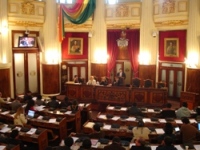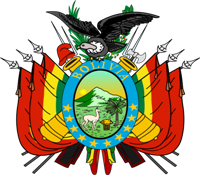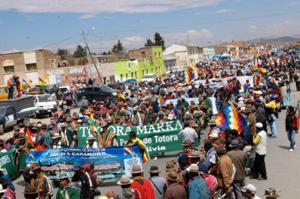
Congress, Chamber of Deputies

Bolivian Coat of Arms
Current political structure
Bolivia, as defined by the 2009 constitution, is a plurinational republic. The Plurinational Legislative Assembly consists of a 130-member Chamber of Deputies (elected on a combination of a single-member constituency and plurinominal systems) and a 36-member Senate. The presidential and legislative terms are for five years.
Political parties
The principal traditional parties are the conservative Nationalist Democratic Action (ADN), the social democratic Movement of the Revolutionary Left (MIR), and the centre-right Nationalist Revolutionary Movement (MNR). However, nontraditional political groupings and alliances have become major political forces since 2002. Nontraditional groups include the Movement Toward Socialism (MAS) and the Pachakuti Indigenous Movement (MIP). Both have gained substantial support, with the MAS currently holding the presidency and a majority of seats in Congress. The main opposition grouping is presently the Plan Progreso para Bolivia - Convergencia Nacional (PPB-CN) alliance. Unidad Nacional, headed by Samuel Doria Medina, is also significant.
Heads of state
Bolivia's first president was Simon Bolivar (Aug-Dec 1825)
Since 1964:
Mainly de facto (military) rule:
1964-1969 - Gen. René Barrientos
1969- (27 April - 26 Sept) Luis Adolfo Siles Salinas
1969-1970 - Gen. Alfredo Ovando Candía
1970-1971 - Gen. Juan José Torres Gonzáles
1971-1978 - Gen. Hugo Banzer Suárez
1978 (Jul-Nov) - Gen. Juan Pereda Asbún
1978-1979 - Gen. David Padilla Arancibia
1979 (Aug-Nov) Walter Guevara Arce
1979 (1 Nov-16 Nov) - Gen. Alberto Natusch Busch
1979-1980 - Lidia Gueiler Tejada
1980-1981 - Gen. Luis García Meza Tejada
1981-1982 - Gen. Celso Torrelio Villa
1982 (Jul-Oct) - Gen. Guido Viloso Calderón
Since return to democracy:
1982-1985 - Hernán Siles Zuazo
1985-1989 - Victor Paz Estenssoro
1989-1993 - Jaime Paz Zamora
1993-1997 - Gonzalo Sánchez de Lozada
1997-2001 - Hugo Banzer Suárez
2001-2002 - Jorge Quiroga Ramírez
2002-2003 - Gonzalo Sánchez de Lozada
2003-2005 - Carlos Mesa Gisbert
2005-2006 - Eduardo Rodriguez Veltzé
2006-2010 - Evo Morales Ayma
2010-present - Evo Morales Ayma (re-elected)
History
Bolivia became independent in 1825, bringing together a number of disparate provinces of the former Spanish empire. Prior to independence there had been a number of indigenous risings, notably one led by Tupac Katari in the 1780s.
Suffering from strong internal rivalries and chronic political instabilities, Bolivia became a prey to its neighbours. In 1883, as a consequence of its defeat by Chile in the War of the Pacific (1879-83), it lost its maritime province centred on Antofagasta, and with it land of huge mineral wealth. In 1903, it lost the district of Acre to Brazil. In the Chaco War (1932-35) it lost extensive territory to Paraguay.
Politics since 1952
A defining political moment in the 20 th century was Bolivia's 1952 revolution, in which the old oligarchic state was replaced by governments dominated by the Movimiento Nacionalista Revolucionario (MNR), an alliance between sectors of the middle and working class around a nationalistic ideology. As a consequence of the 1952 revolution, all Bolivians won the right to vote, the country's larger mines (the mainstay of the economy) were nationalised and an agrarian reform launched. The miners' federation, the FSTMB, and then the general workers' union the Central Obrero Boliviano (COB) became powerful social actors. The Agrarian Reform also gave rise to peasant unions, initially linked to the MNR.
A succession of MNR governments came to an end with the 1964 military coup. This ushered in a period of mainly military governments that was to last until 1982. Although some of these adopted a left-wing stance (e.g. those of Generals Ovando and Torres in the late 1960s and early 1970s), the overall drift was to the right. The Banzer dictatorship (1971-78) was clearly right-wing. The military tried to develop an alliance with peasant unions as a counterpoint to the militant FSTMB. A period of attempted democratisation (1978-80) was truncated and gave rise to a series of short-lived military governments closely linked to the emerging drugs mafias (1980-82).
The re-establishment of democracy in 1982 led to a period of constitutional government backed by inter-party pacts. The return of the MNR in 1985 brought about an abrupt about-turn in economic management, and the onset of a period of liberalisation and privatisation, with the closure of most state-owned mines. President Sánchez de Lozada (1993-97) privatised much of the rest of the public sector, including the oil and gas industry. However, the country's parties became increasingly distant from the ordinary concerns of voters, seemingly keener to avail themselves of the spoils of office than represent those who voted for them.
Bolivia's importance as a producer of coca (the raw material for cocaine) meant it became targeted by successive US administrations for coca eradication. This reached a peak during Banzer's second government (this time constitutional) between 1997 and 2001. Forced eradication contributed to the rise of Evo Morales as a union leader in the Chapare during the late 1990s. Morales only narrowly missed being elected president in 2002, finally becoming the first truly indigenous leader to become president of his country (in which 62% identify themselves as indigenous) in 2005.
The rise of Evo Morales was accompanied by waves of anti-government protest and the re-emergence of social movements as powerful actors. The Cochabamba 'water war' (1999-2000) was a revolt by rural and urban workers, in alliance with consumers, against plans to allow privatised water and sewerage services in Bolivia's third largest city to be taken over by a subsidiary of the US Bechtel Corporation. Bechtel was eventually forced to hand the service company back to a partially consumer-controlled company for the token sum of US$1. The uprising forced the Banzer government to abort an important part of its privatisation programme. The coca workers of the Chapare led the fight against forcible eradication. Indigenous groups on the Altiplano contributed to the development of a new 'ethnic politics'. Peasants, rural workers and lowland indigenous groups challenged land monopolisation by a small landowning elite in Santa Cruz. In October 2003, Sánchez de Lozada's second government was ousted after he sent the military in to deal with protests in El Alto, the mainly poor township that abuts the capital La Paz. 67 people were killed.
The landslide victory of Morales in the 2005 elections (54%) ushered in a period of unaccustomed political stability. The new government brought the gas industry under tighter state control in 2006, raising the taxes payable by foreign investors in the hydrocarbons sector. The government also presided over the elaboration of a new constitution that, amongst other things, enhanced indigenous rights. It was fiercely opposed by elites from the relatively more prosperous eastern departments which sought to establish autonomy from the central government in La Paz. This, however, did not prosper. In 2008, Morales survived a recall referendum by an ample margin, and went on to be re-elected in December 2009 by an even larger margin (64%) than he achieved in 2005.
|




